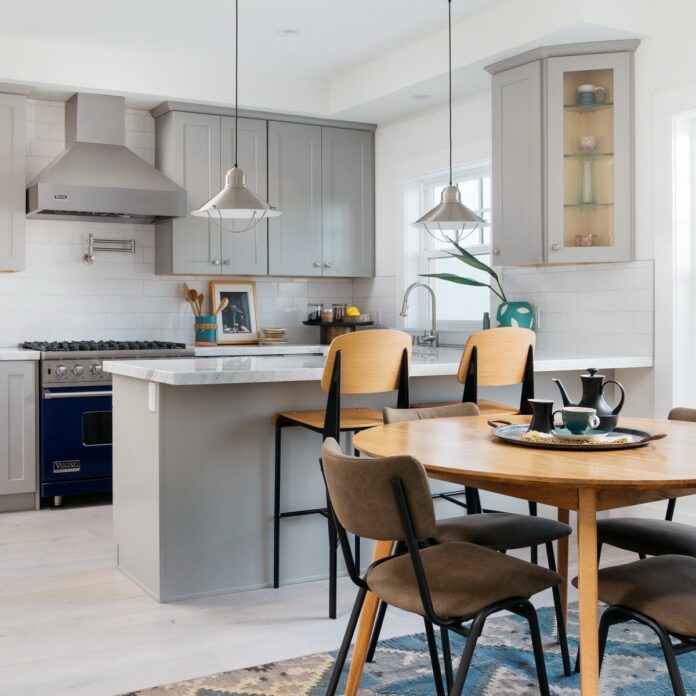When you have limited space or limited budget, some people can see that kitchen islands and dining room tables can serve the same function. They both can be places where you eat and entertain. Dining tables and kitchen islands are also extra surface space that’s valuable for other activities, not just cooking, but everyday activities like working from home or even family game night.
But which of these is a better choice when looking at the overall usefulness and improving the quality of your life?
Let’s take a side-by-side comparison and find out:
Cooking: Kitchen Island
There is absolutely no doubt that the kitchen island is going to win this one. Its proximity to the other appliances like the stove and the refrigerator is perfect for preparing and heating food. The countertop surface is designed to take spills and stains and it would be easier to clean up.
If you moved the dining room table closer to the kitchen, it might have the same effect with some disadvantages. The horizontal surface of a dining table is lower to the ground. Some people may need to stoop or bend over to do the same preparations as they would on kitchen islands. Tablecloths are a part of the dining table because dining surfaces don’t plan for tumbled food.
Eating Meals: Dining Table
Eating is a time of rest and sitting down to eat is a comfort when you might be on your feet all day at work or running errands. Dining tables are at a height that is comfortable with the standard chair. The tradition of eating together with family and friends around a dining table is a bonding experience.
For kitchen islands, you can have barstools for sitting while eating. However, not all bar stools have backs, forcing people to sit more upright or lean into a counter for more support. While stools are not required for eating, standing around an island can feel rushed or even impersonal.
EntertainingAdvantage: Dining TableThere’s a reason why dining chairs are often sold in sets of two or four; dining is a social experience. The word origin of “companion” is derived from the French where the literal translation is “someone to share bread with.” Mealtimes are places of bonding and dining tables are sometimes oval or circular so people can see each other. Even in television and movies, families or groups around a dining room table are important, intimate scenes.
The kitchen island can also be also for entertaining, but usually, someone is cooking in that situation. If you are a host serving your guests, it’s a very good location for that specific scenario. However, it does not feel as intimate as a dining table. It feels like unless someone is actively doing a task, people can go to the living room instead to relax.
Workspace: Kitchen Island
The kitchen island table is not designed for a bonding experience; in a sense, it’s more of a workspace. It is not a surprise those who work from home treat the kitchen island like an impromptu office. The flat, angular surface of a kitchen island is desk-like. In the past, when land telephones and answering machines were more common, island spaces were valuable for work calls.
There’s not a strong disadvantage to using the dining table as a workspace. The dining table is a large, flat space with plenty of places to put your paperwork and projects. However, if you have large groups like families, you need to put work away for others for meals and gatherings. Dining tables as solitary workspaces may feel luxurious, but more selfish when there are others in the house.
Best for small spaces:Advantage: Kitchen Island
Kitchen islands can easily serve as a dining space if you have a cozy apartment or an intimate breakfast nook. Depending on the placement, the kitchen island works as a room divider, helping to outline the spaces of the rooms. Having the island independent from the counter will make it feel bigger, however, the proportions need to be considered. If you cannot get around the kitchen easily, it will always feel cramped, no matter how it looks.
However, the reverse is not equally as true: A dining room table doesn’t work well as a substitute for a kitchen island. The height of the dining table needs to be higher to be an efficient surface for the rest of the kitchen. More importantly, the surface should be scratch and stain resistant since kitchens deal with messes, hot things and sharp items. Although we use cutting boards and trivets to buffer our surfaces, being slightly careless will do little harm to countertops. The same is not true of a dining table, which is not set up for that kind of use.
Kitchen Island Or Dining Table?
Kitchen islands and dining tables are similar enough that you can do comparable functions on either. Yet the height and the more durable work surface yield a slight edge to the kitchen island. Keep in mind, this is if you only had room and budget for ONE of these structures in your home. The dining table is more traditional and works great as a centerpiece for a dedicated dining room. But the kitchen island’s versatility is one of the reasons it is the most requested remodeling jobs in today’s kitchens.










